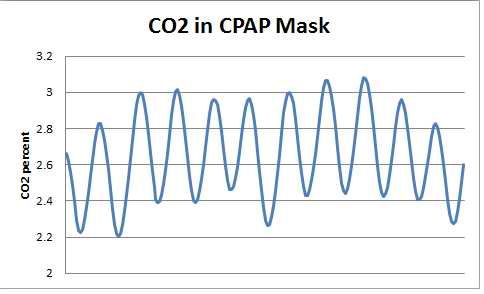miltf wrote:Thanks for all the responses.
As you can see, the level of CO2 never drops below 2.2% or so, so it doesn't matter what the deadspace volume is, I'm still breathing 2% or higher CO2.
You need to learn to think in terms of what is happening dynamically and in terms of pre and post vent placement running with real time air flow rates.
I believe that if you changed the measurement system sample point physical placement point in the mask your results would vary widely, especially near the nostril.
At the vent the air is flowing out the vent point constantly at the vent rate. Lets say that is about 2/3 of my vent rate of 30 liters per minute. At rest and in bed I would not expect the minute breathing volume to be above six liters per minute for a normal person. If the breathing waveform were a pure sine wave then the maximum expiration rate would be 8.5 liters per minute and all of the expired air would leave the vent port. The inhalation cycle would immediately start a process of dilution of the “breathed” air in the mask and the path to the nose would become very clean very early. Since the air in the mask is not a direct part of the circuit it's effect would depend upon how the air circulates in the mask during the inhalation phase and would be limited.
But the breathing waveform is not a sign wave. At the start of exhalation it may in fact become quite fast and may for a part of a second breach the 20 liters per minute vent rate and re-breathed air could become backed up into the supply tube. But after the beginning of exhalation things tend to taper off rapidly. By the time inhalation starts exhalation is likely to have been near zero for some time. So most likely the fraction of a breath which became backed up is eliminated long before inhalation starts.
I think that if you locate the air sample point of your measuring system very near a nostril you will find that the CO2 levels drop much more and raise a bit more. What happens in the mask away from the actual nasal air flow is likely very different from what happens elsewhere between the mask and face.
miltf wrote: I may be a pretty shallow breather
If true your actual re-breathed air amounts should be minimal indeed.
miltf wrote: and that might affect my results and the pressure is low and that certainly affects the results, but these are the conditions under which I start CPAP (as set by my doctor) and these are the conditions under which I feel like ripping off my mask. Your results may differ.
When I hear that someone is “ripping off the mask” my first thought is that they have over breathed enough to reduce their blood carbon dioxide levels to the point where it is affecting their chemoreflexes and causing long term facilitated hyperventilation. One very notable thing that I have experienced in that state is a very unnatural air hunger. I know I am at rest and in bed but I am breathing like I am walking up hill – fast. This should not be.
I have found that using eucapnic breathing techniques will evaporate the unnatural breathing hunger in just a few minutes (usually about 40 seconds for me). Some think that the unnatural breathing hunger is caused by changes in the carotid bodies which make them more sensitive in the hypocapnic environment. Others think that the cerebrovascular changes due to the hypocapnic state create such separate states for the central and peripheral chemoreceptors that it throws the system off. Whatever the cause moving toward eucapnia cures it for me every time.
miltf wrote:I appreciate all of the experience expressed here and learning that some people might benefit from higher CO2 to counter central apnia.
As to whether this is safe or not, I can't say. It just feels bad to me and my original point is that some new users might quit from the feeling of not being able to breath. I fixed things for myself by putting a few extra holes into the mask. It feels much better and my AHI is still low, so who can complain.
The parts I used were:
SprintIR sensor from GSS (0-5%)
Generic TTL to USB cable
MegunoLink Pro software for control and data logging
Generic 12V mini-vacuum pump from Ebay
Selectable voltage power supply to control airflow rate (4-12 v)
Generic airlfow meter (0-3 L/min)
Tubing, connectors, and flange nuts
I think I'm over my exploration of CO2 and CPAP. If anyone is interesting in measuring their own mask, take a look at the parts above and make me an offer (by messaging). I can provide all of this (except the software license) plus my control program and tips on use for a reasonable price.
With your set up I think you could do some good Capnography and so measure your actual PetCo2 and infer your PaCO2. I would love to have that capability.
miltf wrote:As to my original comments on silicone, yesterday I tried to bake out the silicone volatiles in a convection oven at 450 F for 1.5 hr. I think I got about 90% of the way to clean for me, so maybe I will be back in the normal world of CPAP soon.
All the best,
Milt
It would be ironic if the volatiles used in CPAP machines also caused OSA.
Some additional search terms for you for Google Scholar, PubMed, or other favorite medical information search engines:
cerebrovascular CO2 reactivity
sleep apnea ventilatory instability
sleep apnea CO2 retention
Well that should get you started.

